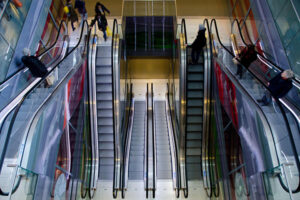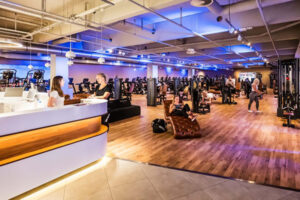By Sebastian Guth
The transformation of brick-and-mortar retail and shopping centers is not a static project, but an ongoing, evolutionary process. We are facing an “eternal problem” that requires continuous adjustments in order to meet the changing needs of customers. This development is inevitably accompanied by economic constraints and conflicting objectives. It is a matter of constantly rethinking and redesigning the use and positioning of the available space, and the marketing and branding of shopping centers, and brick-and-mortar retailers must actively curate this process.
It is important to keep developing the right stories that resonate in both the B2C and B2B sectors. It should not be forgotten that B2B marketing is often the first and most important step: Where there are no tenants, there is no center. It is, therefore, essential to regularly provide new stimuli that excite and inspire both potential tenants and end customers. Today, it is no longer enough to rely on the tried and tested or to copy-paste. Times are tougher and cutthroat competition is increasing. Every “place” must be individually thought through and strategically developed, because “we make places, and the places make us”. The challenge is to create places that not only fulfil current requirements, but are also flexible enough to adapt to future trends and needs.
SHOPPING CENTERS IN TRANSITION: FROM A SHOPPING DESTINATION TO A WORLD OF EXPERIENCE
Today’s shopping centers are faced with a crucial question: How can they reposition themselves in an increasingly digital and experience-oriented world? The traditional concepts in which shopping centers functioned primarily as places for pure shopping are no longer effective. Nowadays, these centers need to offer more to attract and retain customers. The challenge is to transform the shopping center from a place of consumption to a world of experience that seamlessly combines leisure, entertainment, and shopping.
THE ROLE OF SHOPPING CENTERS: FROM RETAILER TO STAGE
Shopping centers need to redefine themselves. They are no longer just landlords of retail space, but have become curators of experiences. This means that they need to expand their role to provide a platform where brands and retailers can tell their stories and present their products in innovative ways. The integration of leisure and entertainment offerings plays a central role here. One way to achieve this is to create more space for experience areas that complement shopping. These could be themed recreation zones, interactive installations, or event spaces where regular events are organized.
These experience spaces invite visitors to linger longer, which, in turn, can increase the turnover of local shops. The creation of so called “third places”, i.e., places that are neither work nor home, contributes to the attractiveness of the shopping center as a social meeting place.
NEW CONCEPTS FOR TENANTS: FLEXIBILITY AND CO-CREATION
This change also means a change for tenants at shopping centers. Instead of traditional, fixed retail spaces, more flexible concepts could be in demand in the future. Pop-up stores, temporary installations, and event spaces shared by different brands could be part of such a new concept. This flexibility allows the shopping center to be designed dynamically and to constantly create new incentives for a visit. Co-creation between shopping centers and their tenants is also becoming increasingly important.
The joint development of experience strategies that are tailored to the target group can help to create a consistent and appealing overall image. This involves not only the physical design of the space, but also the integration of digital elements, such as augmented reality (AR), which enhances the shopping experience on site.
TECHNOLOGY AND DATA ANALYSIS: THE KEY TO SUCCESS
Technology and data analysis play a crucial role in successfully shaping this change. Shopping centers can use data analytics to better understand the behavior of their visitors and adapt their experience strategies accordingly. The use of heat maps, visitor frequency measurements and real-time data makes it possible to identify the most effective areas and concepts and to upgrade less utilized areas in a targeted manner. With the help of digital platforms, shopping centers can also address their visitors directly, make them personalized offers, and thus offer them a tailored experience. These personalized experiences can strengthen customer loyalty and make the shopping center an indispensable part of everyday life.
THE FUTURE OF SHOPPING CENTERS: HYBRIDIZATION OF RETAIL AND EXPERIENCE
The future of shopping centers lies in the hybridization of retail and experience. By leaving their role as pure retail space landlords behind and becoming experience providers, shopping centers can maintain their relevance in a digitalized world. The successful combination of physical and digital space, paired with multisensory experiences and customized offers, will be the key to not only attracting customers, but also retaining them in the long term. Shopping centers that proactively shape this change can establish themselves as innovative and indispensable components of urban life. They will become places that people visit not only to shop, but also to experience community, enjoy entertainment, and discover new things.
WHAT DOES THAT MEAN IN PRACTICE?
In order to successfully shape the transformation of shopping centers, marketing must focus on five central strategies and actively bring them to life:
- Create an Identity: Every shopping center must develop a clear, unique identity that sets it apart from others. This requires strong branding that is tailored to the specific needs and preferences of the target group. The identity should be communicated through a consistent narrative that appeals to all the senses and positions the center as an authentic place with a unique character.
- Innovation and Inspiration Boost Footfall: In order to attract customers time and time again, shopping centers must be designed as dynamic worlds of experience that regularly surprise with innovative formats, events, and multisensory experiences. The center thus becomes a place that customers visit not only to shop, but also to discover new ideas and be inspired.
- Cooperations Create Connections: Strategic partnerships and collaborations with local and international brands, event organizers, and artists can create unique experiences that enliven the center and ensure greater customer loyalty. Such collaborations expand the range of offers and turn the center into a social meeting place.
- Present the Local DNA: Every center should use its local roots and identity to set itself apart from the competition. This means integrating local characteristics and the cultural DNA of the region into the center, be it through local brands, artwork, or events. In this way, the shopping center becomes a place that reflects the local community and embodies its pride.
- Enable Social Interaction and Spontaneity: In an increasingly digitalized world, shopping centers need to create spaces that encourage social interaction and spontaneous encounters. This includes cozy lounge areas, flexible spaces for spontaneous events, and interactive elements that actively involve visitors. By promoting social contact, the center becomes a lively place where people enjoy spending time.
By focusing on these five key areas, marketing can redefine the role of shopping centers in a changing retail landscape. It’s about creating places that are far more than just retail spaces – vibrant, inspiring experiences that bring people together and invite them to explore. It is important to be open to learning and to be open to new and innovative ideas – and, in the end, it certainly takes a bit of luck as well.

Sebastian Guth
Sebastian Guth is the Managing Director of 21Media.







